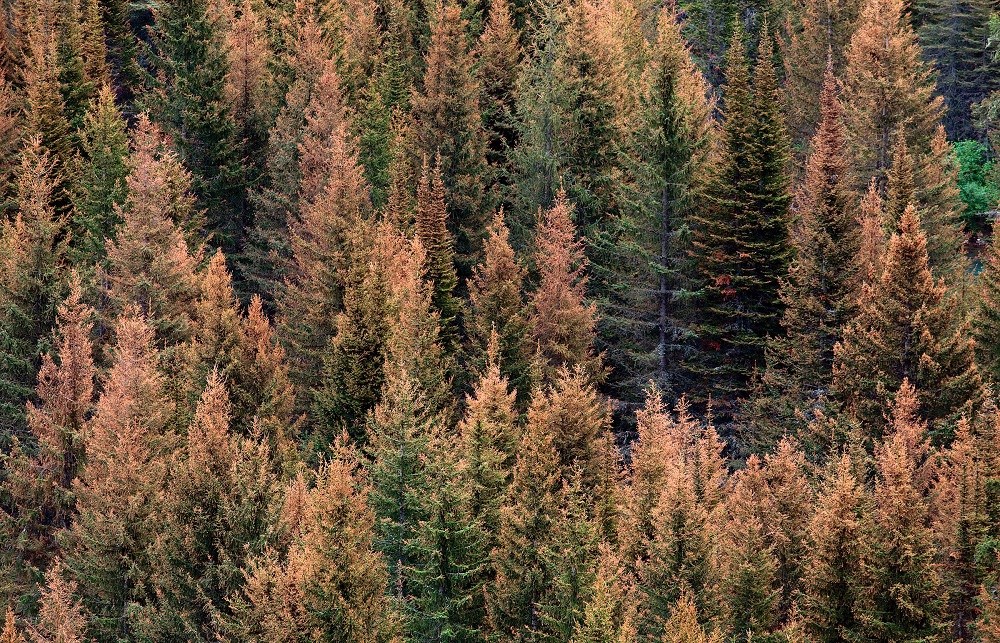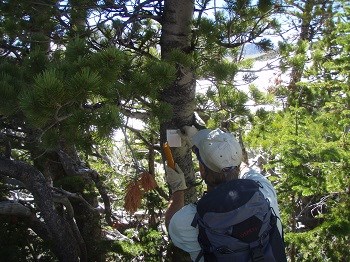Last updated: October 14, 2024
Article
Forest Health Hot Topic
Changing Forests

Chris Peterson
Trees are an everyday part of our lives. They offer us shade, beauty, and color. Their branches, trunks, and leaves provide homes and nutrition to many species of birds and mammals. And when one of them near and dear to us dies, such as a beloved backyard tree, it can even cause us sadness.
Dying forests, once lush and green, but now rife with brittle, lifeless trees, can be even more overwhelming. Seeing huge swaths of red-tipped trees or stands of orange-red trees can cause alarm and raise our concern, especially in meaningful places we care deeply about.
In Glacier, vistas of damaged, sickly trees are becoming wide-spread. Many of us wonder why this is happening and what is being done to protect our forests.
Agents of Change
Glacier’s forests are dynamic. They are continuously changing, as all forest ecosystems are. But recently, a series of cumulative factors has caused rapid change to the look and feel of the park’s forest ecosystems. The combination of forest pathogens, drought, and temperature changes is weakening or altering the area’s forests to the extent that land managers are unclear of their future and how best to manage for the drastic changes taking place.
In recent years, the park’s forests have taken a hit from three main forest pathogens: western spruce budworm, mountain pine beetle, and white pine blister rust. Western spruce budworm is a native orange-brown colored moth that lays its eggs on the underside of conifer needles. The moth favors primarily Douglas fir, grand fir, and subalpine fir trees, but can also affect Engelmann spruce and western larch trees. Spruce budworm larvae devour a tree’s new foliage, causing the tips of the tree’s branches to appear reddish-brown. Although spruce budworm is a destructive defoliator, it typically doesn’t kill the tree. Unless infestations are severe or last more than 3-5 years, it mainly reduces the growth of the tree and can cause the top of the tree to die.
Mountain pine beetle, another insect native to our area, is a member of a group of insects known as bark beetles. It spends its entire life cycle underneath the bark of its host tree until it emerges as an adult and flies away in search of a new tree to lay its eggs. The beetle can reproduce in all species of pine, but outbreaks often develop in dense stands of large, older lodgepole pine and dense stands of mid-sized ponderosa pine. In Glacier, the mountain pine beetle can also attack whitebark pine found in higher elevations.
Unlike the western spruce budworm, a single generation of mountain pine beetles can kill a tree. In their quest for food, the beetles end up girdling the tree, disrupting the essential flow of food and water throughout the tree. Dying trees will generally begin to appear “red and dead” 8-10 months after an attack.
White pine blister rust is a non-native fungus that infects five-needle pines, such as western white pine and whitebark pine. Native to Eurasia, blister rust was accidentally introduced to North America around 1900. The first report of the fungus in Glacier occurred in 1939, and since that time, blister rust has infected over 75% of Glacier’s whitebark pine trees. The disease infects the branches and stems of the tree, causing cankers (dead plant tissue) which kill the branch and eventually the tree itself.
Pushing the Limit
Although forests are in a constant state of change, most ecologists identify two relatively consistent factors. Each forest type transitions towards a specific climax community overtime and all forests experience a variety of disturbances (e.g., fire, insect outbreaks, avalanches, windstorms, etc.) that help to create a healthier and more dynamic system. But in recent decades, significant temperature changes are eliminating much of what we define as “normal” by changing the frequency and duration of known disturbance factors as well as adding possible unknown factors that we may not yet understand.
Glacier’s forests experienced prolonged drought for roughly ten years, from 2000-2010. This lack of moisture weakened many of the tree species in the park, making them more susceptible to attacks from forest pests and pathogens. Drought can take a toll on our forests, but its cyclical nature and fairly common occurrence has created forest ecosystems in the Northern Rocky Mountains that can, for the most part, withstand it. Forest ecosystems have also evolved with forest insects and even severe outbreaks have generally not been seen as a threat to them. What is now different and why land managers are concerned is the added element of a changing climate.
Western Montana is experiencing warmer temperatures and changing weather patterns. Due to its location and climate dynamics, temperatures in Glacier National Park and the surrounding area are increasing 1.8 times faster than the global average. We are also experiencing a greater number of frost-free days each year and temperatures are staying warmer later in the fall and rising earlier in the spring. Along with warmer spring temperatures, we are seeing a greater amount of precipitation falling in the spring, when it is more likely to be rain than snow. Unlike snow, which melts slowly over a period of time, falling rain moves quickly out of the watershed, reducing the amount of water available later in the summer.
All together, these factors contribute to both known and unknown changes occurring in our forests. Research shows that the development, survival, range, and abundance of many forest insects are greatly affected by temperature. Warmer temperatures may reduce winter kills, speed up life cycle rates, and lead to range expansion to higher elevations or higher latitudes for some species. Less snowfall and higher temperatures, along with dead trees from massive insect attacks, may result in an increase in frequency, size, and intensity of wildfires. These cumulative factors could ultimately change the very nature of particular forest types. Insect outbreaks, plus drought, plus fire may alter the successional pathways of a forest, shifting it to a new climax community (e.g., an aspen forest might turn into a grassland).

NPS
Management Strategy
Many visitors are shocked by the drastic changes taking place in Glacier’s forests and wonder what’s being done to save them. Some public and private land managers have attempted to curtail massive forest insect attacks by logging infected trees, spraying insecticides, or implementing pheromone treatments. In national parks, natural processes are often allowed to dictate the ebb and flow of evolving ecosystems. Many parks look at the health of the ecosystem as a whole and implement management policies that cause the least amount of impact. In Glacier, insecticides are not used due to their numerous and often unknown effects to other plants and animals. Infected trees are typically cut down only if they present a hazard to people or buildings.
The park does treat high value trees, trees that are in a high use area or are seen as a healthy tree that might withstand attacks, with anti-aggregation pheromone treatments. Dispersing adult bark beetles typically emit a pheromone that tells other beetles that a tree is fully occupied and new arrivals should look elsewhere to lay their eggs. Pheromone treatments mimic natural pheromones put out by individual insect species, thereby preserving the tree. Currently, Glacier uses pheromone treatments to protect high-value Douglas fir and whitebark pine trees.
As our climate continues to warm, land managers will need to continue to analyze and assess impacts to our forests, watersheds, and wildlife. New ideas and strategies may need to be put in place to cope with the challenges we face in light of a changing climate.
Resources for More Information
Glacier National Park Staff
- Dawn LaFleur, Restoration/IPM Biologist
- Tara Carolin, Director Crown of the Continent Research Learning Center
Documents and web sites
- DNRC Forest Pest Management Program – http://dnrc.mt.gov/divisions/forestry/forestry-assistance/pest-management
- USDA Forest Service Forest & Grassland Health – https://www.fs.usda.gov/detail/r4/forest-grasslandhealth/?cid=stelprdb5364476
- EPA Climate Change – https://www.epa.gov/climate-indicators
The Crown of the Continent Research Learning Center
Phone: 406-888-5827; Email: melissa_sladek@nps.gov
Website: www.nps.gov/rlc/crown
